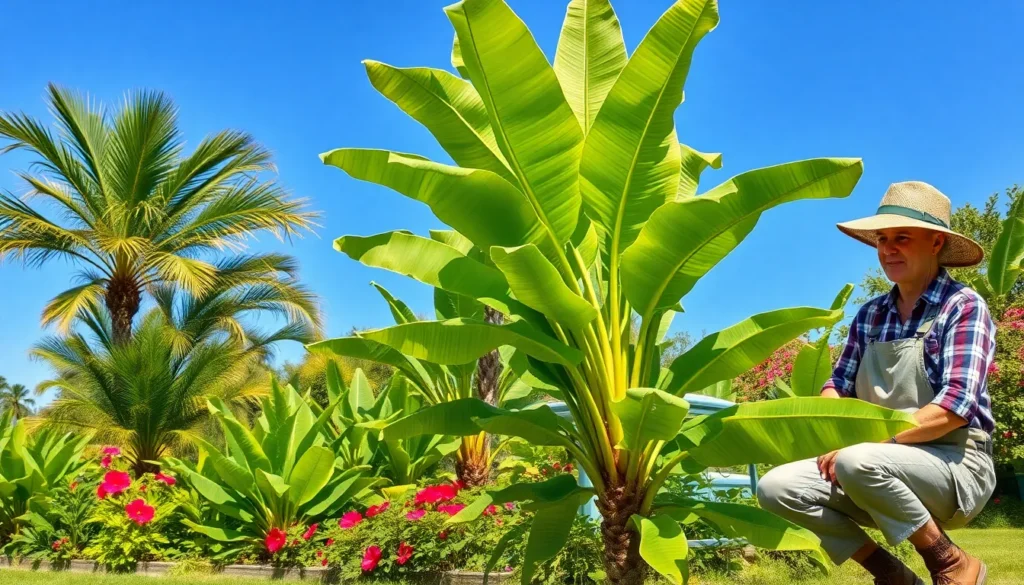We’ve all dreamed of transforming our gardens into tropical paradises with lush foliage and exotic blooms. But what if you live in a climate where winter temperatures regularly dip below freezing? The good news is you don’t have to abandon your tropical garden dreams just because you live in a temperate zone.
Cold hardy tropical plants offer the perfect solution for gardeners who want that coveted tropical aesthetic without relocating to Florida or Hawaii. These remarkable plants combine the stunning visual appeal of their heat-loving cousins with the resilience to survive surprisingly cold temperatures.
From architectural palms that can withstand snow to vibrant flowering shrubs that bounce back after hard freezes, we’ll explore the amazing industry of tropical plants that laugh in the face of winter. You’ll discover how to create your own slice of paradise regardless of your hardiness zone.
Understanding Cold Hardy Tropical Plants and Their Unique Characteristics
Cold hardy tropical plants bridge the gap between exotic aesthetics and practical garden resilience. These remarkable specimens combine the lush appearance we associate with tropical landscapes with the durability needed to survive freezing temperatures.
What Makes a Plant Both Tropical and Cold Hardy
Tropical plants achieve cold hardiness through their genetic heritage and evolutionary adaptations. Many species originate from mountainous tropical regions where temperatures naturally fluctuate between warm days and cold nights. Plants like hardy hibiscus (Hibiscus moscheutos) and windmill palms (Trachycarpus fortunei) developed in climates that experience seasonal temperature drops.
Geographic origin plays a crucial role in determining cold tolerance. Species from higher elevations in tropical zones often possess natural antifreeze compounds in their cellular structure. Hardy bananas such as Musa basjoo evolved in regions of Japan and China where winter temperatures regularly drop below freezing.
Botanical classification helps us identify potentially cold hardy varieties within tropical plant families. Palms from the Trachycarpus genus consistently show superior cold tolerance compared to their Caribbean cousins. Bamboo species from temperate Asian regions maintain their tropical appearance while surviving temperatures as low as -10°F.
Temperature Tolerance Ranges for Different Species
| Plant Type | Species Examples | Temperature Range | USDA Zones |
|---|---|---|---|
| Hardy Palms | Windmill Palm, Needle Palm | -5°F to 10°F | 7b-11 |
| Cold Hardy Bamboo | Phyllostachys, Fargesia | -20°F to 0°F | 5-9 |
| Tropical Shrubs | Hardy Hibiscus, Camellia | 0°F to 15°F | 6-10 |
| Exotic Perennials | Canna Lily, Colocasia | 10°F to 20°F | 7-11 |
Different cold hardy tropical species demonstrate varying levels of temperature tolerance based on their exact adaptations. Windmill palms withstand temperatures down to -5°F when properly established, making them suitable for zone 7b gardens. Needle palms (Rhapidophyllum hystrix) survive even colder conditions, tolerating temperatures as low as -10°F in protected locations.
Hardy bamboo varieties showcase exceptional cold tolerance while maintaining their tropical appearance. Phyllostachys species survive temperatures reaching -20°F in some cases, though their above-ground portions may suffer damage. Clumping bamboos like Fargesia offer similar cold hardiness with less aggressive spreading habits.
Flowering tropical plants require exact temperature thresholds to survive winter conditions. Hardy hibiscus dies back to the ground in freezing weather but regrows from hardy root systems in spring. Camellias maintain their evergreen foliage through winter temperatures down to 0°F, providing year-round tropical appeal.
Adaptation Mechanisms That Allow Tropical Plants to Survive Cold
Cellular modifications enable tropical plants to survive freezing temperatures through specialized biochemical processes. Cold hardy varieties produce natural antifreeze proteins that prevent ice crystal formation within plant tissues. These cryoprotectants lower the freezing point of cellular fluids, protecting vital plant structures during winter months.
Root system adaptations provide crucial survival advantages for cold hardy tropical plants. Deep taproot systems allow plants to access unfrozen soil layers where temperatures remain stable. Extensive lateral root networks store energy reserves needed for spring regrowth after winter dormancy periods.
Protective structures develop naturally in cold adapted tropical species to shield sensitive growing points. Thick bark formation protects woody stems from freeze damage, while dense leaf sheaths surround palm growing tips. Bamboo culms develop waxy coatings that reflect sunlight and minimize temperature fluctuations.
Dormancy strategies help tropical plants conserve energy during cold periods. Herbaceous varieties like hardy gingers enter complete dormancy, retreating to underground rhizomes until spring warmth returns. Evergreen species reduce metabolic activity while maintaining minimal photosynthesis throughout winter months.
Selecting the Right Cold Hardy Tropical Plants for Your Climate Zone
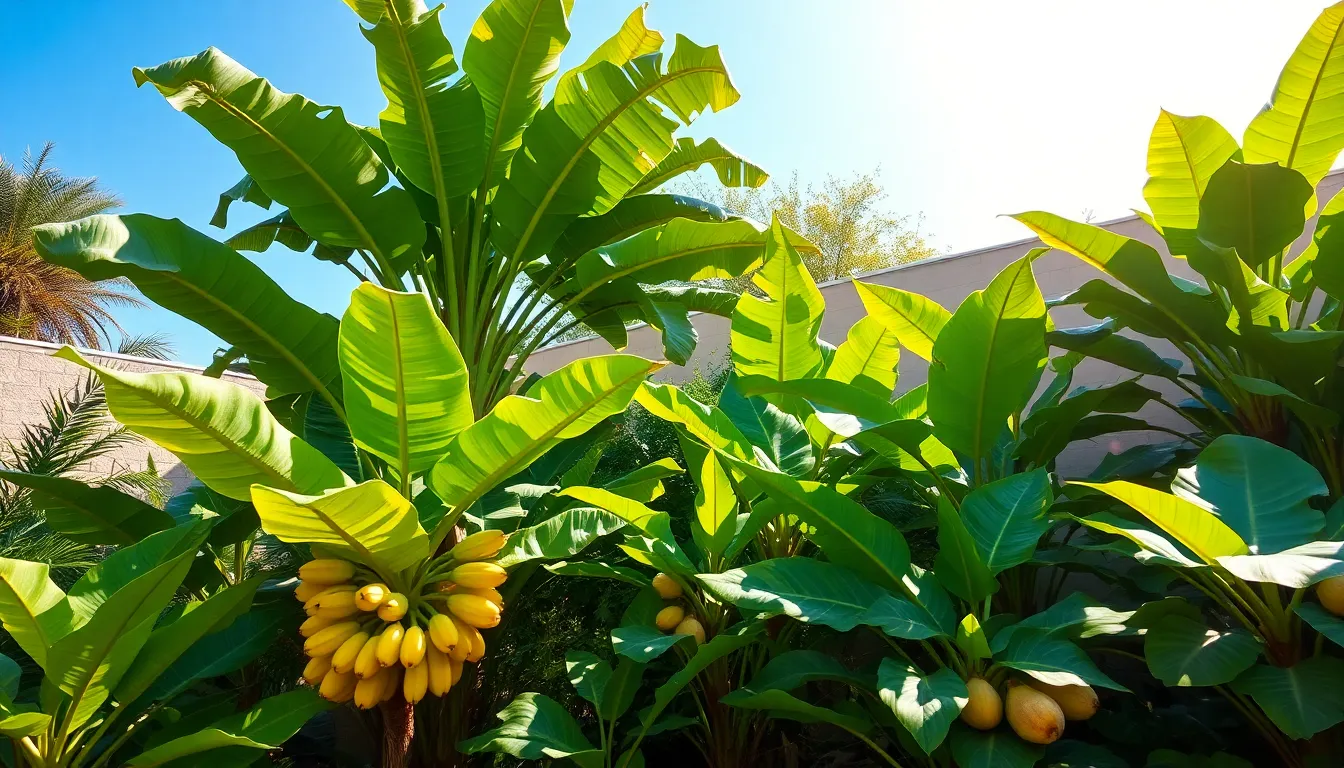
Now that we understand how these resilient plants adapt to colder conditions, let’s explore how to choose the perfect specimens for your exact location.
USDA Hardiness Zones and Tropical Plant Selection
Understanding your USDA Hardiness Zone is the foundation for successful cold hardy tropical plant selection. The USDA Plant Hardiness Zone Map divides regions based on average annual minimum winter temperatures, providing a crucial framework for plant survival.
Zone classification directly determines which tropical plants we can grow successfully in our gardens. Traditional tropical plants thrive in Zones 10 and 11, but cold hardy varieties extend our options into much colder territories. The Hardy Fiber Banana exemplifies this resilience, surviving in Zones 5-11 with its impressive large foliage and golden flowers.
Temperature tolerance varies significantly among cold hardy tropical species. Chicago Fig demonstrates exceptional cold resistance, withstanding temperatures as low as -20°F once established and thriving from Zone 5 to 10. Similarly, the Olympian Fig offers reliable performance in Zones 6-10, making it accessible to gardeners in regions previously considered too harsh for tropical aesthetics.
Japanese Aralia extends tropical garden possibilities into Zone 7, while various cold hardy figs expand our choices even further north. Selecting plants rated for your exact zone ensures winter survival and eliminates the disappointment of losing prized specimens to unexpected cold snaps.
Microclimates and Their Impact on Plant Survival
Microclimates create unique growing conditions that can significantly expand our cold hardy tropical plant options beyond standard USDA guidelines. These localized zones develop distinct temperature, humidity, and wind patterns that differ from the surrounding area.
Strategic placement near south facing walls provides additional heat retention and protection from harsh winds. Heat absorbing surfaces like concrete or stone can create warmer zones that allow us to grow plants rated for one zone warmer than our official designation. Sheltered areas protected by structures or existing vegetation offer similar advantages.
Elevation changes within our property create natural microclimates, with lower areas typically staying warmer due to cold air drainage. Understanding these subtle variations helps us position cold hardy tropical plants in the most favorable locations for survival and growth.
Wind protection plays a crucial role in plant survival, as cold winds can damage tropical foliage even when temperatures remain above freezing. Creating windbreaks with existing hardy plants or structures extends our plant selection possibilities considerably.
Researching Local Success Stories and Regional Varieties
Local gardening communities provide invaluable insights into which cold hardy tropical plants thrive in exact regional conditions. Connecting with fellow gardeners who’ve successfully grown tropical plants in similar climates saves us time and money while expanding our plant knowledge.
Regional nurseries specializing in exotic or cold hardy plants often stock proven performers for local conditions. These specialists frequently recommend plants like Curcuma (Hidden Cone Ginger), Canna Lilies, and Hedychium (Ginger Lilies), which have demonstrated success in cooler climates through local testing.
Documented success stories help identify exact varieties with superior cold tolerance. Beer’s Black Fig, prized for its dark fruit and exceptional cold resistance, has proven its ability to survive in Zone 5 with proper winter protection. These real industry examples guide our plant selections more effectively than general hardiness ratings alone.
| Plant Name | Zone Range | Special Features |
|---|---|---|
| Hardy Fiber Banana | 5-11 | Large foliage, golden flowers |
| Chicago Fig | 5-10 | Survives -20°F, frost resistant |
| Olympian Fig | 6-10 | Excellent frost tolerance |
| Beer’s Black Fig | 5+ | Dark fruit, extra winter protection needed |
| Japanese Aralia | 7+ | Architectural foliage |
Gardening forums and social media groups focused on cold hardy tropical plants offer ongoing support and seasonal advice. Members share photos of their successes and failures, providing visual confirmation of what works in different microclimates and growing conditions throughout various regions.
Top Cold Hardy Tropical Plants for Foliage Drama
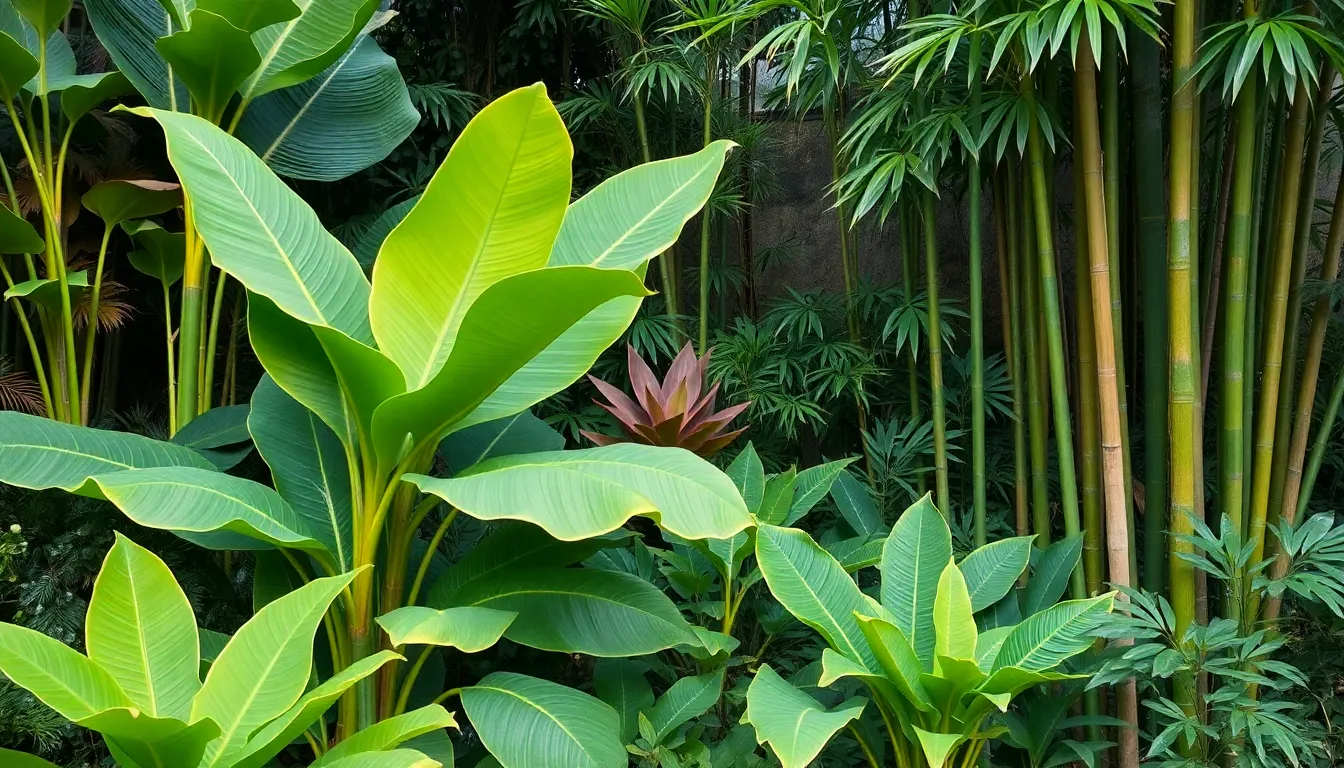
We’ve compiled the most stunning cold hardy tropical plants that’ll transform your temperate garden into a lush paradise.
Japanese Fiber Banana (Musa basjoo)
Musa basjoo stands as the most cold hardy banana variety available, thriving in USDA zones 5-11 where traditional tropical plants can’t survive. These magnificent plants produce leaves up to 6 feet long and 2 feet wide, creating instant tropical drama with their vibrant green foliage.
Unlike typical banana plants, the Japanese Fiber Banana’s root system withstands freezing temperatures while maintaining that coveted tropical aesthetic. Each plant develops golden cream flowers followed by small seedy fruit, adding ornamental value beyond just foliage appeal.
We recommend this variety for gardeners seeking reliable tropical impact without frost damage concerns. The massive leaves create stunning focal points in temperate landscapes while providing that authentic banana plant experience in surprisingly cold climates.
Hardy Bamboo Varieties
Hardy bamboos deliver unmatched vertical drama while surviving freezing temperatures that would kill other tropical looking plants. These resilient varieties create dense privacy screens and garden accents with their tall, graceful culms and lush foliage.
Bamboo’s distinctive texture adds instant tropical flair to cold climate gardens where traditional tropical species fail. The plants maintain their green appearance throughout winter in many regions, providing year round visual interest when other plants go dormant.
We’ve found hardy bamboos particularly effective for creating tropical garden rooms and natural screens. Their fast growth habit means you’ll achieve that desired tropical look faster than with most other cold hardy alternatives.
Cold Tolerant Palms and Cycads
Cold hardy palms extend tropical aesthetics into USDA zone 7 and sometimes colder with proper winter protection. These architectural plants maintain their distinctive fan or feather fronds even during colder months, providing structural tropical interest year round.
Cycads offer prehistoric tropical appeal with their tough, stiff leaflets that withstand moderate cold temperatures. These ancient plants add unique texture combinations that you won’t find in typical temperate garden plants.
We particularly value these plants for their ability to create tropical focal points that persist through winter. Their strong architectural forms provide garden structure while delivering that unmistakable tropical vibe even in temperate climates.
Best Cold Hardy Tropical Plants for Stunning Flowers
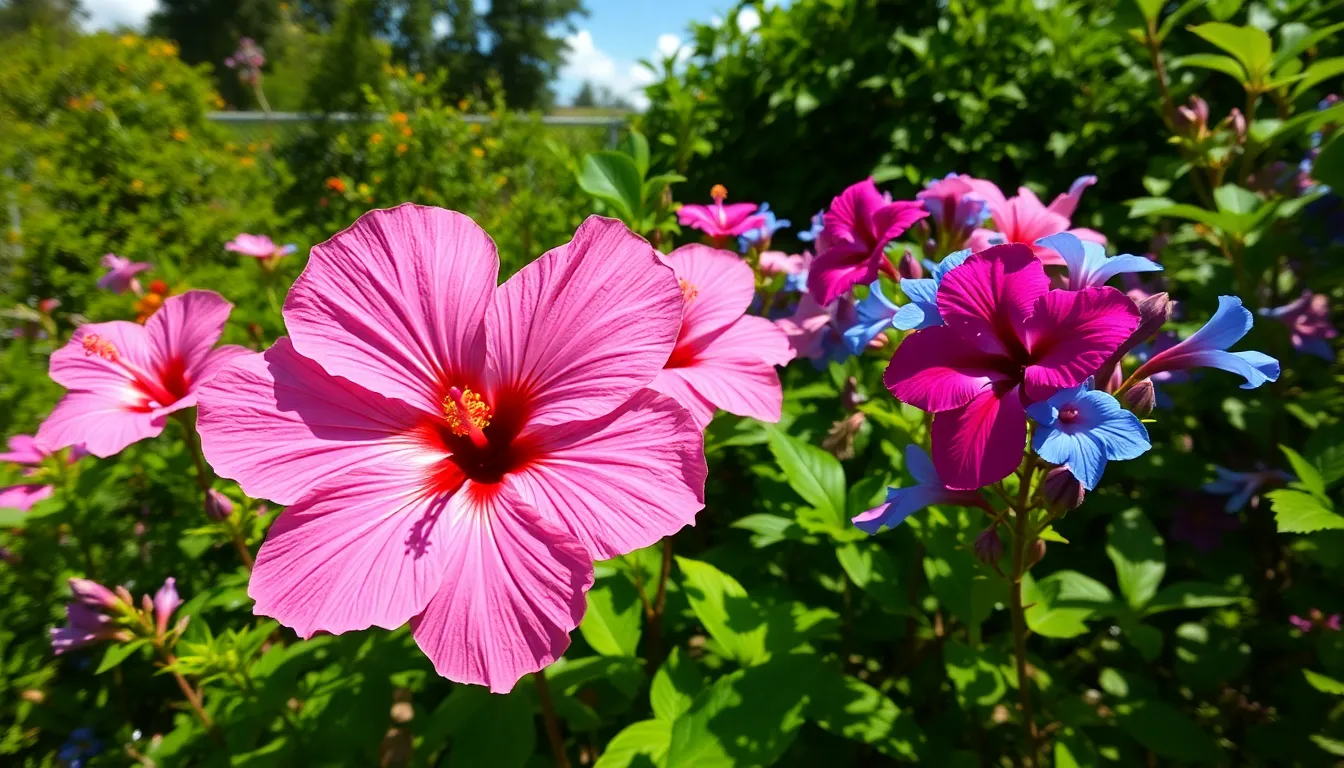
When you’re seeking the perfect tropical blooms that can weather winter’s chill, these flowering powerhouses deliver both resilience and spectacular beauty. These remarkable plants prove that stunning tropical flowers aren’t limited to frost-free climates.
Hardy Hibiscus Species
Hardy hibiscus stands out as the ultimate showstopper for cold climate tropical gardens. These herbaceous perennials produce dinner plate-sized blooms that can reach impressive dimensions during summer months. Unlike their tropical cousins, hardy hibiscus varieties die back completely in winter but return with vigorous growth when warmer seasons arrive.
Thriving in USDA Zones 4-10 makes hardy hibiscus accessible to gardeners across diverse climates. The Head Over Heels® series offers spectacular blooms in white, pink, and red varieties that create stunning garden displays. Popular cultivars like Blush Hibiscus feature pale pink flowers complemented by striking burgundy foliage that adds year-round interest.
Rose of Sharon represents another exceptional hibiscus option for cold hardy tropical gardens. Flourishing in USDA Zones 5-9, this resilient shrub tolerates poor soils and drought conditions better than most hibiscus varieties. The Chateau™ Series produces nonstop blooms from early summer through autumn, offering colors ranging from white with crimson centers to blue-violet shades.
Cold Tolerant Bougainvillea Varieties
Cold tolerant bougainvillea varieties require careful selection and strategic winter protection. While most bougainvillea species prefer consistently warm climates, certain varieties can survive brief cold periods when provided with proper shelter and care. Gardeners in borderline zones often succeed by choosing protected planting locations and implementing winter protection strategies.
Specialized care techniques enable bougainvillea survival in cooler climates. Heavy mulching around the root zone helps insulate the plant’s foundation during temperature drops. Container growing allows gardeners to move plants to protected areas during harsh weather periods, extending their growing season significantly.
Microclimate creation becomes essential for bougainvillea success in cold hardy tropical gardens. Planting against south-facing walls or in courtyards provides additional warmth and wind protection. These strategic placement choices can extend the viable growing range by one or two hardiness zones.
Tropical Flowering Vines That Survive Frost
Frost tolerant tropical vines create vertical drama while withstanding challenging winter conditions. These climbing beauties add height and dimension to cold hardy tropical gardens without sacrificing their exotic flowering appeal. Strategic planting in sheltered locations enhances their survival rates through harsh weather periods.
Hardy climbing varieties often include specialized tropical vine selections. Ginger lilies (Hedychium species) and certain canna varieties function as climbing or tall vertical elements in garden designs. These plants provide tropical aesthetics while maintaining impressive cold tolerance ratings.
Winter protection strategies maximize tropical vine survival in borderline climates. Heavy mulching around root systems provides essential insulation during temperature drops. Wrapping techniques using burlap or frost cloth create protective barriers that allow these tropical beauties to survive unexpected cold snaps.
Sheltered planting locations significantly improve tropical vine performance in cold climates. Positioning vines near heat-retaining structures like stone walls or buildings creates beneficial microclimates. These strategic placements can mean the difference between plant survival and winter loss in challenging growing zones.
Protecting Your Cold Hardy Tropical Plants During Winter
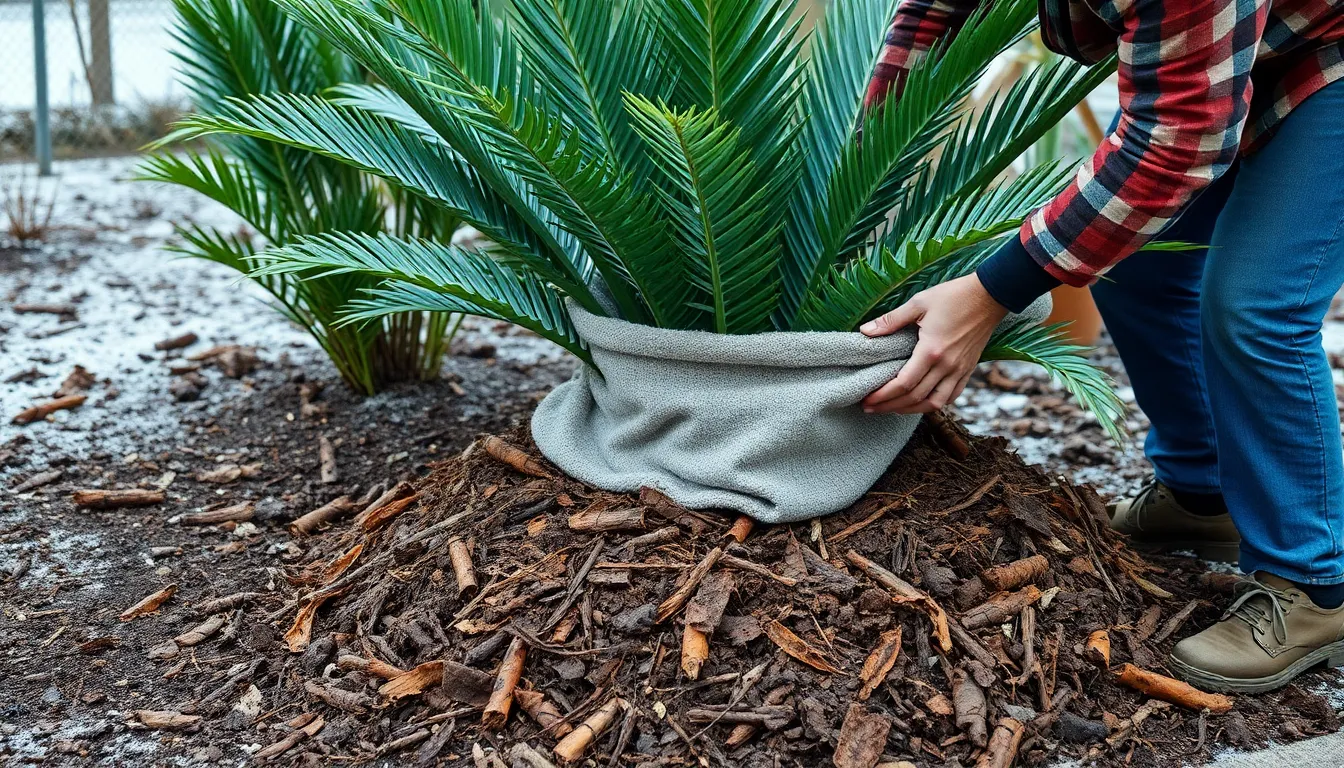
Winter protection becomes essential when temperatures drop below our cold hardy tropical plants’ tolerance levels. Effective strategies can mean the difference between thriving plants and costly losses.
Mulching Techniques for Root Protection
Apply thick organic mulch around the base of each plant to create an insulating barrier that reduces radiant heat loss from soil. Pine bark, shredded leaves, and wood chips work exceptionally well for this purpose. Root systems benefit tremendously from this protection since frozen roots often cause more damage than cold air exposure to foliage.
Maintain a 4-6 inch mulch layer extending from the plant base to the drip line for maximum effectiveness. Container plants require special attention – we recommend placing mulch around pots to minimize heat loss through container walls. Moisture retention improves significantly with proper mulching, preventing dangerous temperature fluctuations that stress plant roots.
Wrapping and Covering Strategies
Cover plants with sheets, blankets, or frost cloths when temperatures drop to 30°F-32°F, especially for species like Bougainvilleas that need light frost protection. Always anchor coverings to the ground to trap heat radiating from soil beneath the plants. Plastic should never touch plant surfaces directly – instead, use it as an outer layer over blankets to retain warmth more effectively.
Protect tall palms by tying up fronds and wrapping the growing tip with towels or blankets, since this central growth point determines the plant’s survival. Laying down flexible plants and covering them with multiple insulating layers provides superior protection during severe cold snaps. Natural windbreaks like fences or buildings shield plants from damaging cold winds during advective freezes.
Container Growing for Seasonal Movement
Move container plants indoors or to protected areas during cold weather to ensure their survival through harsh winter conditions. Group containers close together when indoor movement isn’t possible, then surround them with mulch or insulating materials to reduce collective heat loss. Positioning containers near walls or inside sheltered locations minimizes exposure to frigid winds that can quickly damage tropical foliage.
Select appropriate container sizes that allow root systems to establish properly while remaining manageable for seasonal relocation. Wheeled plant caddies make moving larger specimens much easier when cold snaps approach unexpectedly.
Planting and Establishing Cold Hardy Tropical Plants Successfully
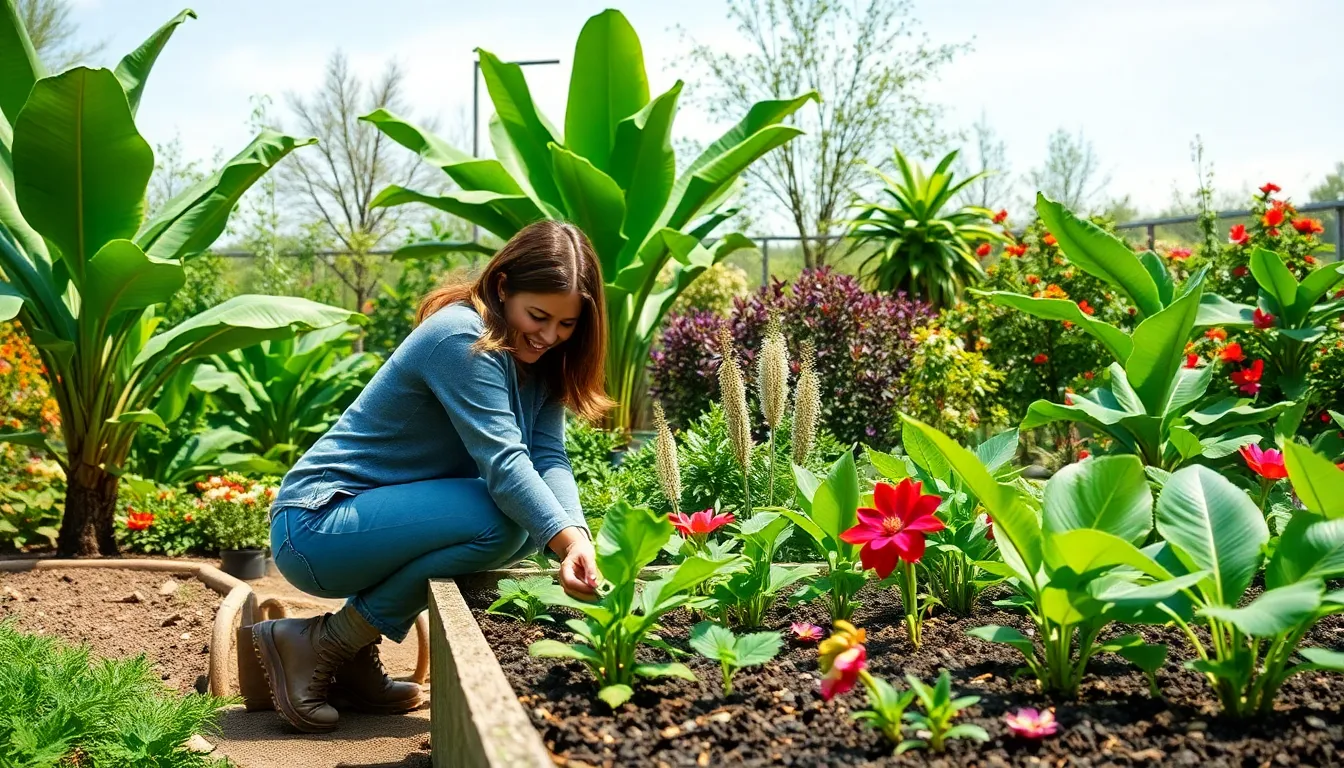
Successfully establishing cold hardy tropical plants requires strategic timing and proper care techniques. These resilient plants can transform your garden with exotic beauty while surviving harsh winters when planted correctly.
Optimal Planting Times and Soil Preparation
Spring planting offers the best success rates for cold hardy tropical plants. We recommend planting after the last frost when soil temperatures consistently stay above 50°F. This timing gives plants like Hardy Fiber Banana and Chicago Fig the longest growing season to develop strong root systems before winter arrives.
Soil preparation determines whether your plants thrive or struggle through their first winter. Amend heavy clay soils with compost, aged manure, or perlite to improve drainage since waterlogged roots often die during freezing temperatures. Well-draining soil prevents root rot that commonly kills tropical plants in colder climates.
pH levels should stay between 6.0 and 7.0 for most cold hardy tropical species. Test your soil and adjust with lime to raise pH or sulfur to lower it. Japanese Aralia and cold-hardy hibiscus perform best in slightly acidic to neutral conditions.
Raised beds provide superior drainage and root protection for sensitive species. Build beds 6-8 inches high using quality topsoil mixed with organic matter. This elevation prevents water from pooling around roots during wet winter months.
Initial Care and Watering Requirements
Deep watering schedules help newly planted tropicals establish robust root systems. Water thoroughly twice per week rather than light daily watering, soaking the soil 8-10 inches deep. This encourages roots to grow downward where soil temperatures remain more stable.
Mulching protects roots from temperature fluctuations while conserving moisture. Apply 3-4 inches of organic mulch like shredded bark or leaves around the base, keeping it 2 inches away from plant stems. Pine bark works exceptionally well for acid-loving species like hardy figs.
Monitor soil moisture levels carefully during the first growing season. Stick your finger 2-3 inches into the soil to check moisture before watering. Overwatering kills more newly planted tropicals than underwatering, especially during cooler months.
Established plants become more drought tolerant but still need consistent moisture. Reduce watering frequency after the first year, but maintain deep watering sessions during extended dry periods. Hardy Fiber Banana and similar species show stress quickly when water becomes limited.
Fertilization Schedules for Tropical Plants in Cooler Climates
Balanced fertilization supports vigorous growth during the active growing season. Apply slow-release fertilizer with equal N-P-K ratios in early spring when new growth appears. This provides steady nutrition for 3-4 months without burning tender roots.
Nitrogen-rich fertilizers promote lush foliage growth through midsummer. Use formulations with higher nitrogen content during May through July to encourage the tropical appearance these plants are known for. Avoid high-nitrogen feeding after August 1st to prevent frost-tender growth.
Phosphorus and potassium become critical for winter hardiness preparation. Switch to fertilizers with higher P-K ratios in late summer to strengthen cell walls and improve cold tolerance. This helps plants like rose of Sharon and cold-hardy hibiscus survive temperature drops.
Stop fertilizing 6-8 weeks before your first expected frost date. Late-season fertilization stimulates new growth that cannot harden off before winter arrives. This tender growth often dies back, weakening the entire plant for spring recovery.
| Fertilizer Type | Application Timing | N-P-K Ratio | Purpose |
|---|---|---|---|
| Slow-release balanced | Early spring | 10-10-10 | Initial growth support |
| High nitrogen | May-July | 20-10-10 | Foliage development |
| Winter prep | Late summer | 5-10-15 | Cold hardiness |
Troubleshooting Common Problems With Cold Hardy Tropical Plants
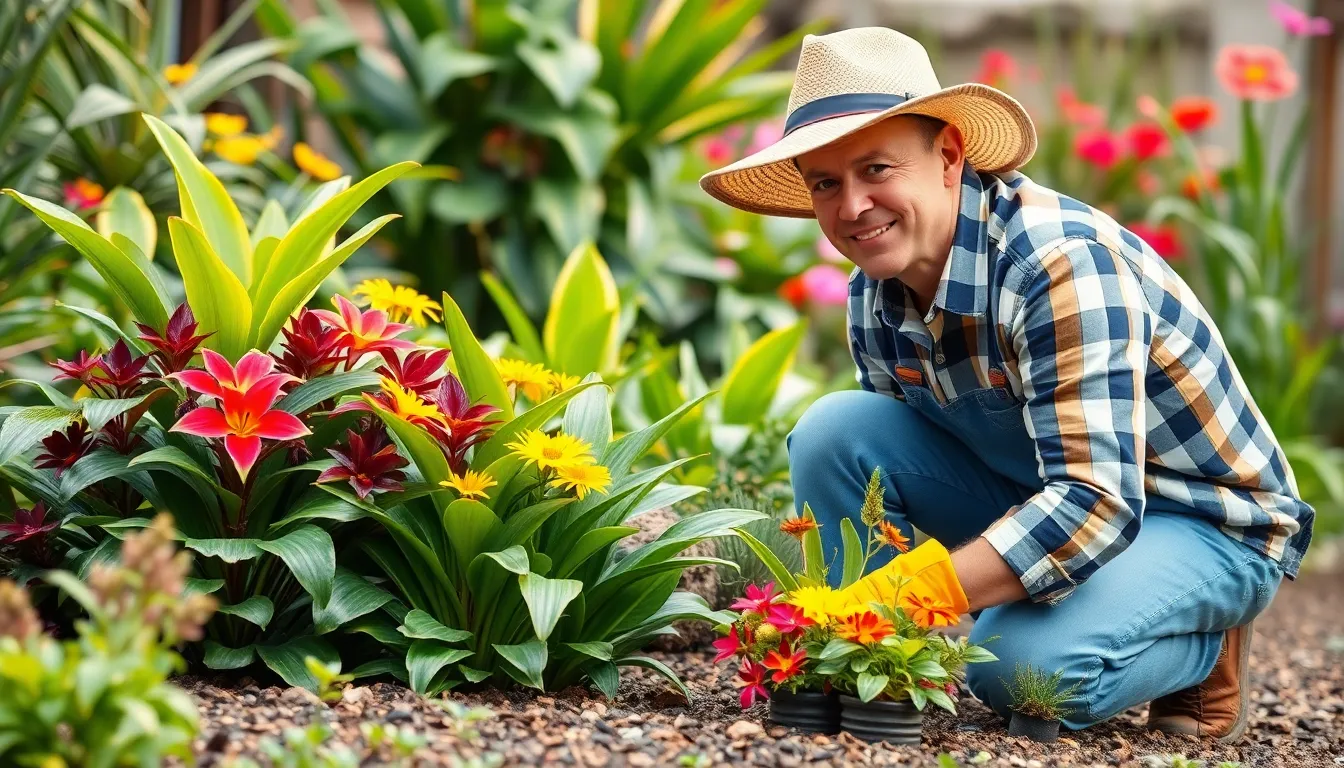
Even the most resilient cold hardy tropical plants can face challenges when adapting to temperate climates. Understanding common issues and their answers ensures we maintain healthy, thriving tropical gardens year round.
Identifying Cold Damage and Recovery Methods
Spotting the early signs of cold damage helps us respond quickly before permanent harm occurs. Browning or blackening leaves appear first, followed by wilting and sudden leaf drop that signals cellular damage. Damaged stems often show dark, mushy areas where frost has penetrated plant tissues.
Recovery begins immediately after identifying cold damage through strategic pruning of affected foliage. We should wait until after the last frost to remove damaged portions, as seemingly dead tissue can still provide protection. Plants like the Olympian Fig can lose all their leaves but regrow vigorously when spring arrives, demonstrating remarkable resilience.
Root protection becomes critical during recovery periods through heavy mulching around the base. We apply 4-6 inches of organic mulch to insulate root systems and prevent further damage. Frost cloths or protective covers shield vulnerable plants during unexpected cold snaps, maintaining crucial temperature buffers.
Pest and Disease Management in Transitional Climates
Transitional climate zones expose our cold hardy tropical plants to pest combinations rarely encountered in their native habitats. Aphids and spider mites thrive in the fluctuating conditions between tropical and temperate zones, attacking stressed plants recovering from cold exposure.
Regular inspection schedules help us catch infestations before they spread throughout our tropical plant collections. We examine leaf undersides weekly for early signs of spider mites or aphid colonies. Fungal diseases develop rapidly in humid conditions common during seasonal transitions.
Organic management approaches work effectively without damaging cold stressed plants that need gentle care. Horticultural oils applied during mild weather periods control pest populations while supporting plant recovery. Good air circulation prevents fungal issues that commonly affect tropical plants in changing climates.
Nutrient Deficiencies in Non-Native Soil Conditions
Temperate soils often lack the nutrient profiles that cold hardy tropical plants require for optimal growth and cold tolerance. Nitrogen, potassium, and magnesium deficiencies appear as yellowing foliage and reduced vigor in plants adapted to richer tropical soils.
Soil testing reveals exact nutrient gaps that we can address through targeted fertilization programs. We conduct annual soil tests to monitor pH levels and nutrient availability for our tropical plant collections. Balanced fertilizers designed for tropical species provide the trace elements missing from temperate garden soils.
Organic matter addition improves both soil texture and nutrient retention in gardens supporting cold hardy tropical plants. We incorporate compost and well-aged manure to create growing conditions that more closely match tropical soil profiles. Regular mulching with organic materials slowly releases nutrients while improving soil structure for better root development.
Creating Tropical Landscapes in Cold Climates
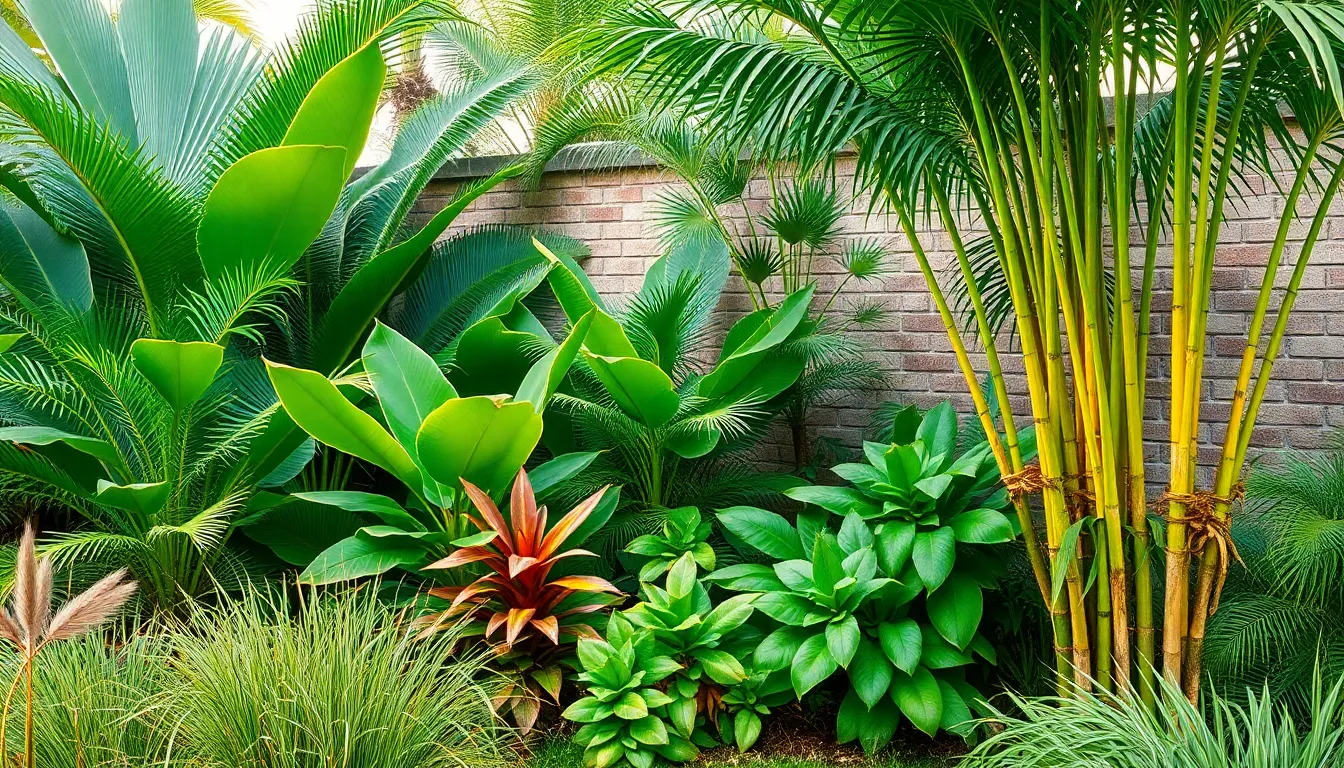
Building a lush tropical oasis in colder regions becomes achievable when we understand the unique requirements of cold hardy tropical plants. Strategic planning and thoughtful design choices transform challenging climates into stunning landscapes that evoke the warmth of the tropics year-round.
Design Principles for Cold Hardy Tropical Gardens
Microclimate utilization forms the foundation of successful cold hardy tropical gardens. We recommend selecting planting locations with excellent drainage and protection from cold drying winds, such as south-facing walls or sheltered corners that enhance survival rates significantly. These protected spaces create temperature buffers that can mean the difference between plant survival and winter kill.
Layering and texture create visual depth that mimics authentic tropical environments. Incorporating plants with contrasting leaf shapes and textures—such as fan palms, broad-leaved bananas, and bamboo—builds the lush aesthetic we’re seeking. Trachycarpus fortunei (Windmill palm) provides elegant architectural structure, while Musa basjoo (Japanese banana) adds dramatic foliage contrast.
Hardy variety selection ensures long-term garden success without constant replanting. Plants like Japanese banana and clumping bamboo varieties deliver height and tropical appeal without risking winter mortality. Sabal minor (Dwarf palmetto) and Rhapidophyllum hystrix (Needle palm) serve as reliable backbone plants that tolerate temperatures well below freezing while maintaining their tropical appearance.
Winter protection strategies extend the viable plant palette considerably. Mulching, pruning to stumps, and installing wind barriers protect sensitive plants during the coldest months. These techniques allow us to experiment with marginally hardy species that might not otherwise survive our climate zone.
Companion Planting with Native Cold Weather Plants
Native plant integration creates resilient garden ecosystems that support tropical specimens. Combining cold hardy tropicals with native cold-tolerant species establishes diverse gardens where local plants provide ground cover, structural support, and wind protection that enhances the cold tolerance of tropical companions.
Ecological balance emerges naturally when we pair tropical plants with regional natives. This strategic approach promotes pest resistance and reduces maintenance requirements while creating visually cohesive landscapes. Native ornamental grasses complement palm fronds beautifully while providing winter interest when tropical plants enter dormancy.
Complementary aesthetics develop through careful selection of companion plants. Evergreens native to our region offer year-round structure that bridges the gap between tropical specimens and local climate expectations. These partnerships create gardens that feel both exotic and appropriately situated within their geographic context.
Wind protection becomes a crucial service that native plants provide to tender tropicals. Established native shrubs and trees create sheltered microclimates where cold hardy tropical plants can flourish with reduced stress from winter weather patterns.
Seasonal Interest and Year-Round Appeal
Evergreen tropical selections maintain visual impact throughout winter months. Plants like Rhapidophyllum and Sabal palms retain their foliage through winter, providing consistent tropical structure when other plants have died back or gone dormant.
Deciduous tropical dynamics add seasonal excitement to garden compositions. Cold-hardy bananas that die back but regrow in spring create dramatic seasonal changes that keep gardens interesting throughout the year. These plants offer the best of both worlds—tropical impact during growing season and manageable winter cleanup.
Bamboo provides structural winter interest that bridges seasonal transitions. Resilient bamboo varieties maintain their vertical presence during cold months, creating focal points and privacy screens when other plants have retreated underground.
Color integration through companion plants extends flowering seasons beyond tropical blooms. Strategic placement of seasonal flowering plants that thrive within our climate zone ensures continuous color throughout the growing season, complementing the foliage-focused tropical elements during their peak performance periods.
Long-Term Care and Maintenance of Cold Hardy Tropical Plants
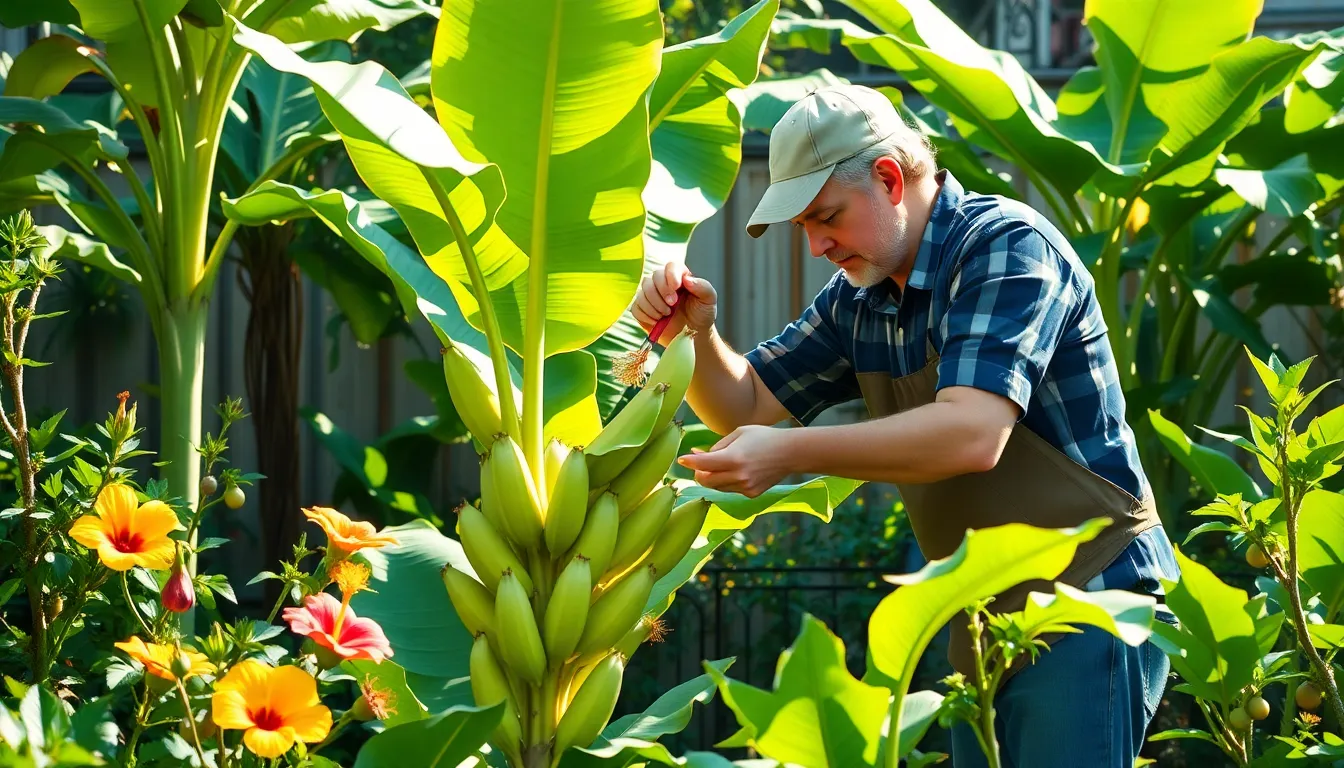
Once we’ve successfully established our cold hardy tropical plants, maintaining their health and vigor requires a strategic approach that differs from traditional tropical care. We’ll need to adapt our maintenance routines to support plants that bridge two distinct growing environments.
Pruning Techniques for Different Plant Types
Hardy bananas like Musa basjoo require exact timing for optimal results. We should remove dead or damaged leaves only after winter passes, avoiding any cuts to green healthy parts during dormancy periods. This approach protects the plant’s energy reserves and prevents additional stress during vulnerable winter months.
Hardy hibiscus and Rose of Sharon benefit from late winter or early spring pruning. We can stimulate robust blooming by cutting back old wood to healthy buds, removing weak or crossing branches that compete for nutrients. These plants respond well to aggressive pruning since they bloom on new wood.
Fig varieties like Chicago Fig and Olympian Fig need careful winter pruning schedules. We should wait until late winter or early spring to remove weak or crossing branches while maintaining the plant’s natural shape. This timing prevents sap loss and reduces the risk of winter injury to fresh cuts.
Frost damaged foliage requires patient assessment before removal. We must wait until plants show clear signs of new growth before pruning any material that appears dead from cold exposure. Premature pruning can harm the plant’s natural recovery process and reduce overall vigor.
Seasonal Care Schedules and Maintenance Tasks
Spring tasks focus on recovery and renewed growth preparation. We should remove frost damaged foliage once new growth appears, begin our fertilizing schedule, and gradually increase watering as plants emerge from dormancy. This season sets the foundation for robust summer performance.
Summer maintenance emphasizes consistent moisture and pest monitoring. We need to maintain steady soil moisture without overwatering, regularly inspect for pest issues, and provide support stakes for larger tropical specimens that may become top heavy. Regular deadheading of flowering varieties extends bloom periods.
Fall preparation gradually transitions plants toward winter dormancy. We should slowly reduce watering frequency and stop fertilizing to allow plants to naturally harden off for winter. This gradual reduction helps trigger the dormancy process that’s crucial for cold survival.
Winter care requires minimal but strategic intervention. We must water sparingly during extended dry spells since evergreen tropicals continue losing moisture through their foliage even during dormancy. Root protection with mulch and avoiding early pruning are essential winter practices.
Propagation Methods for Expanding Your Collection
Division works exceptionally well for clumping tropical varieties. We can divide rhizomes or roots from plants like Canna and Hardy Ferns in early spring before active growth begins. This method produces mature plants quickly and maintains the parent plant’s cold hardiness characteristics.
Stem cuttings provide reliable propagation for many tropical shrubs. We should take softwood or semi hardwood cuttings from species like Hibiscus and Japanese Aralia, ensuring proper humidity levels during the rooting process. Summer cuttings typically root faster than those taken during cooler months.
Seed propagation offers the most genetic diversity but requires patience. We can grow cold hardy fig and banana species from seeds, though this method produces slower growing plants that may take several seasons to reach maturity. Seeds from locally adapted plants often show better cold tolerance.
Layering techniques work particularly well for shrubby tropical species. We can encourage root formation by layering branches from plants like Rose of Sharon directly into surrounding soil while they remain attached to the parent plant. This method ensures successful rooting before separation occurs.
Conclusion
We’ve shown you that achieving a tropical paradise in cold climates isn’t just possible—it’s surprisingly achievable with the right plant selections and care techniques. These remarkable cold hardy tropical plants offer the best of both worlds: exotic beauty and practical resilience.
Success with these plants comes down to understanding their unique needs and adapting our gardening approach accordingly. From selecting the right species for your hardiness zone to implementing proper winter protection strategies we’ve outlined the essential steps for long-term success.
Your tropical oasis awaits regardless of where you live. With proper planning strategic plant placement and consistent care routines you can enjoy lush foliage vibrant blooms and that coveted tropical atmosphere year after year. The key is starting with quality cold hardy varieties and committing to their specialized care requirements.
Frequently Asked Questions
What are cold hardy tropical plants?
Cold hardy tropical plants are resilient species that combine exotic tropical aesthetics with the ability to survive freezing temperatures. They often originate from mountainous tropical regions where they developed natural adaptations like antifreeze proteins, specialized root systems, and protective structures such as thick bark and waxy coatings to endure harsh winter conditions.
Can tropical plants really survive winter in cold climates?
Yes, many cold hardy tropical plants can survive winter in cold climates. For example, windmill palms can withstand temperatures as low as -5°F, while hardy bamboo varieties can survive even colder conditions. These plants use dormancy strategies and natural adaptations to conserve energy and protect themselves during winter months.
How do I choose the right cold hardy tropical plants for my climate zone?
Understanding your USDA Hardiness Zone is crucial for successful plant selection. Research specific temperature tolerance ranges for each plant species, consider your local microclimates, and connect with regional nurseries for advice. Plants like Hardy Fiber Banana and Chicago Fig can thrive in much colder regions than traditional tropical plants.
What winter protection do cold hardy tropical plants need?
Key winter protection strategies include applying 4-6 inch layers of organic mulch around roots, wrapping sensitive plants with frost cloths during cold snaps, and moving container plants indoors or grouping them with insulating materials. Bougainvilleas and other sensitive species require extra attention during freezing temperatures.
When is the best time to plant cold hardy tropical plants?
Spring planting after the last frost is optimal for cold hardy tropical plants. This timing allows plants to establish strong root systems before facing their first winter. Ensure well-draining soil, proper pH levels, and implement deep watering schedules with mulching to support healthy establishment.
How do I care for cold hardy tropical plants year-round?
Seasonal care involves gradual transitions in watering and fertilization to support dormancy and recovery. Prune different plant types specifically – hardy bananas, hibiscus, and figs each require unique pruning techniques. Regular inspections for pests and diseases, along with soil testing for nutrient deficiencies, ensure optimal health.
What are the best cold hardy tropical plants for beginners?
Japanese Fiber Banana (Musa basjoo) thrives in USDA zones 5-11 and provides impressive tropical impact. Hardy hibiscus species produce stunning large blooms in zones 4-10. Hardy bamboo varieties offer year-round visual interest and vertical drama, making them excellent starter plants for cold climate tropical gardens.
How can I create a tropical landscape design in a cold climate?
Utilize microclimates by selecting well-draining locations and incorporating layering with different textures to mimic authentic tropical environments. Companion planting with native cold-weather plants creates resilient ecosystems. Include evergreen tropical selections and strategically placed flowering plants for year-round visual appeal and continuous color.

